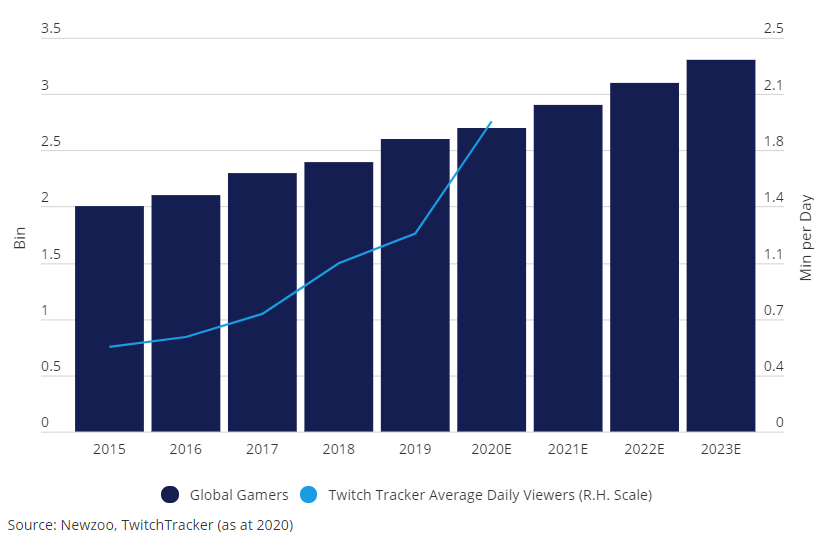9 stocks to ride the online gaming boom
Some readers may remember the early days of video games – whether the thrilling chases in Pac-Man or driving along Rainbow Road in Mario Kart. The video game industry has greatly evolved since then. Over the past two decades, advances in technology, especially the exponential growth in computing power, have allowed play to morph from standalone consoles to online via mobile phones. The resulting increase in sociability has created many opportunities for making money.
World 1-1
With more powerful computers making home-gaming feasible, the days of feeding coin-operated machines at the local arcade are far behind us. Faster, more reliable internet connection has been vital to the gaming market's growth. Traditional media industries such as television and newspapers have struggled in the age of the internet.
By contrast, video-game publishers and developers have thrived, selling in-game downloadable content (DLCs) directly to consumers, and venturing into the smartphone market. New types of games, such as free-to-play (FTP), have emerged as a result of the shift from hardware to software gaming. The ecosystem has developed to the point where gamers can venture into ‘uncharted’ lands, like eSports and streaming services.
Breath of the Wild
Gaming’s popularity as a source of entertainment has accelerated in recent years, regardless of age, gender or income. According to industry research group Newzoo, the global gamer market has grown 35% in the past five years and is forecast to reach 3.2 billion in three years’ time.
Over the past ten years, the proportion of female gamers in the US has increased from 38% to 45%. Meanwhile, age distribution has become less skewed toward younger people. Indeed, some studies suggest video games can enhance cognitive function and well-being in healthy older adults. More recently, a new source of entertainment and income has emerged - streaming video gamers - with Covid-19 restrictions accelerating its popularity.
"Gaming’s popularity as a source of entertainment has accelerated in recent years, regardless of age, gender or income."
Competitive gaming has been around for years but the astronomical rise of eSports has been unprecedented, particularly among younger people. While once-maligned, sentiment towards eSports is now shifting. Sponsors and media rights are driving up revenue. The Defence of the Ancients (Dota) 2 finals tournament hit headlines when the top five players took home US$3.1 million. This is just US$750,000 less than Rafael Nadal’s winnings at the 2019 US Open Tennis Championship.
Reports indicate that total eSports viewership grew from roughly 205 million to 440 million over the past five years. It is forecast to reach over 600 million in 2023 (see Chart 1). TwitchTracker has calculated that, amid Covid-19 lockdowns, the average number of viewers rose over 60% in April 2020, up roughly 100% over the year.
Chart 1: Overwatching Overwatch?

Level Up
Much like Pokѐmon evolution, the business models are levelling up to align with the evolving industry landscape, as publishers sell an increasing proportion of games online through digital platforms. This partly reflects increased popularity. More importantly, though, it represents cannibalisation of hardware sales at brick-and-mortar stores. Software sales enhance profitability. By cutting out third-party distributors, publishers can sell games directly over the web at the retail price. Software sales also avoid costs associated with hardware disc sales, such as warehousing and disc/case printing. Profit margins for games publishers Ubisoft, EA and Activision Blizzard have expanded from 17% to 36% over the past decade, partly as a result of this shift from hardware to software.
eSports, too, has created a new business model, offering additional sources of income for game publishers from sponsorship, TV rights and organisers. Mobile eSports has attracted millions of viewers across the globe. For example, Tencent’s ’King of Glory’ Pro League Fall Season 2018 Playoffs had 20 million viewers. More traditional video game publishers have been able to sell franchise team spots in their eSports leagues, similar to many traditional sports leagues. Activision Blizzard caused a stir after selling spots in its Overwatch League for US$20 million each.
Continue? Yes/No
There are many ways to invest within this ecosystem. The most direct would be through game publishers such as Activision Blizzard (NAS:ATVI) and Electronic Arts (NAS:EA). Then there are hardware components companies like Nvidia (NAS:NVDA) and AMD (NAS:AMD) which develop the graphics processors and other vital computer chips for gaming monitors, mobiles and consoles. Gaming console plays are another option – with Sony (NYS:SNE) and Microsoft (NAS:MSFT) releasing new offerings later in 2020.
Accessing the eSports theme via streaming platforms tends to be trickier, as many have been snapped up. For instance, Amazon (NAS:AMZN) acquired Twitch for $970 million in 2014. There are, though, some listed pure-play streaming platforms like Huya (NYS:HUYA) and Bilibili (NAS:BILI). The outlook for this industry is bright, with the emergence of cloud gaming and eSports providing many opportunities. The recent Covid-19 lockdown has accelerated ongoing trends. The constituents of these indices have been surprisingly defensive in the aftermath of the market crash.
Developments in cloud gaming would also provide a subscription-based revenue platform, thereby providing a stable stream of revenue for companies. Faster broadband speeds will play into the hands of these cloud-gaming providers.
Better stock up on the Pokeballs - there are lots of opportunities out there to catch.
Never miss an insight
Keep up to date with Aberdeen Standards latest thinking by hitting the follow button below.
3 topics
.png)
.png)